Choosing the right small business suppliers can make or break your company’s success. At SmallBizToolbox, we’ve seen firsthand how crucial this decision is for entrepreneurs.
Finding reliable vendors who offer quality products at competitive prices is essential for maintaining your profit margins and customer satisfaction. This guide will walk you through the process of selecting the best suppliers for your small business needs.
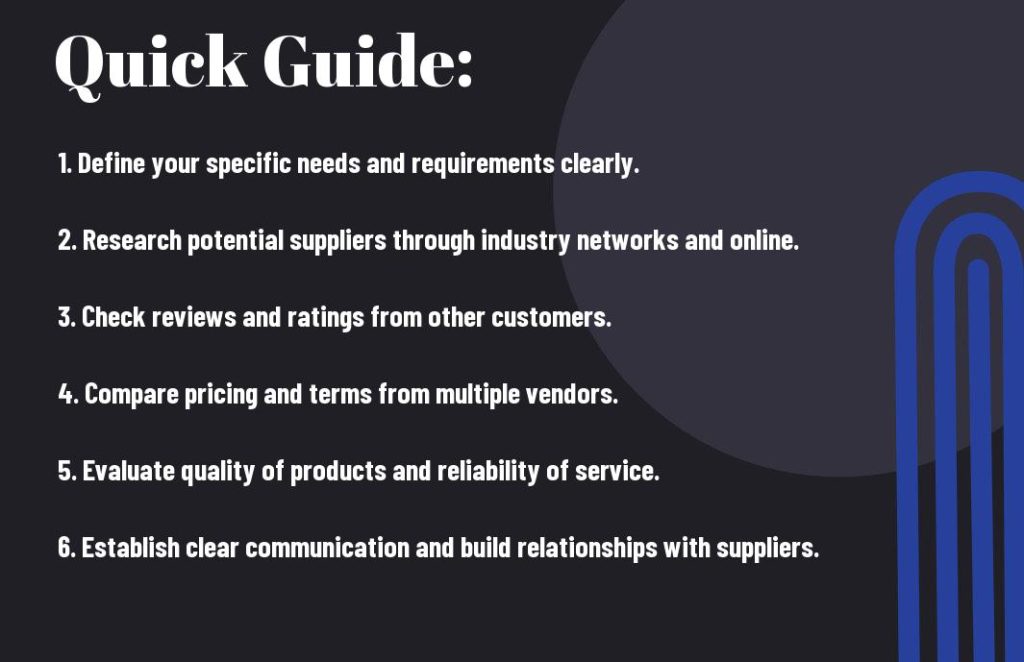
Define Your Business Needs and Requirements
Identify Essential Products or Services
The first step in choosing the right suppliers is to define your business needs. Create a comprehensive list of all products or services your business requires to operate effectively. For a café, this might include coffee beans, milk, pastries, and cleaning supplies. A tech startup might need software licenses, hardware components, and office equipment. Don’t overlook minor items – they can significantly impact your operations.
Establish Quality Standards
Quality objectives should be measurable, consistent with the quality policy and relevant to product and service conformity. Set clear criteria for each product or service you need. If you source organic produce, specify the required certifications. For manufacturing businesses, detail acceptable defect rates and material specifications. These standards will guide your supplier selection process and help maintain consistency in your offerings.
Analyze Budget Constraints
Budget considerations play a vital role in supplier selection. Calculate how much you can spend on supplies without compromising your profit margins. Consider not just the unit cost, but also shipping, storage, and potential waste. Evaluate your cash flow to ensure you can meet typical supplier payment terms.
Determine Volume Requirements
Volume requirements influence your supplier choices. Some suppliers offer better rates for bulk purchases, which can tie up more capital. Ordering smaller quantities more frequently can help with cash flow but might increase per-unit costs. Find a balance that aligns with your business model and storage capabilities.
Assess Scalability Needs
Your business needs will likely change as you grow. Consider your future requirements when selecting suppliers. Can they accommodate increased order volumes? Do they offer a wide enough product range to support your expansion plans? Investing in cloud-based solutions early on can be a smart approach, as these are scalable and can prevent the need for costly, disruptive upgrades later.
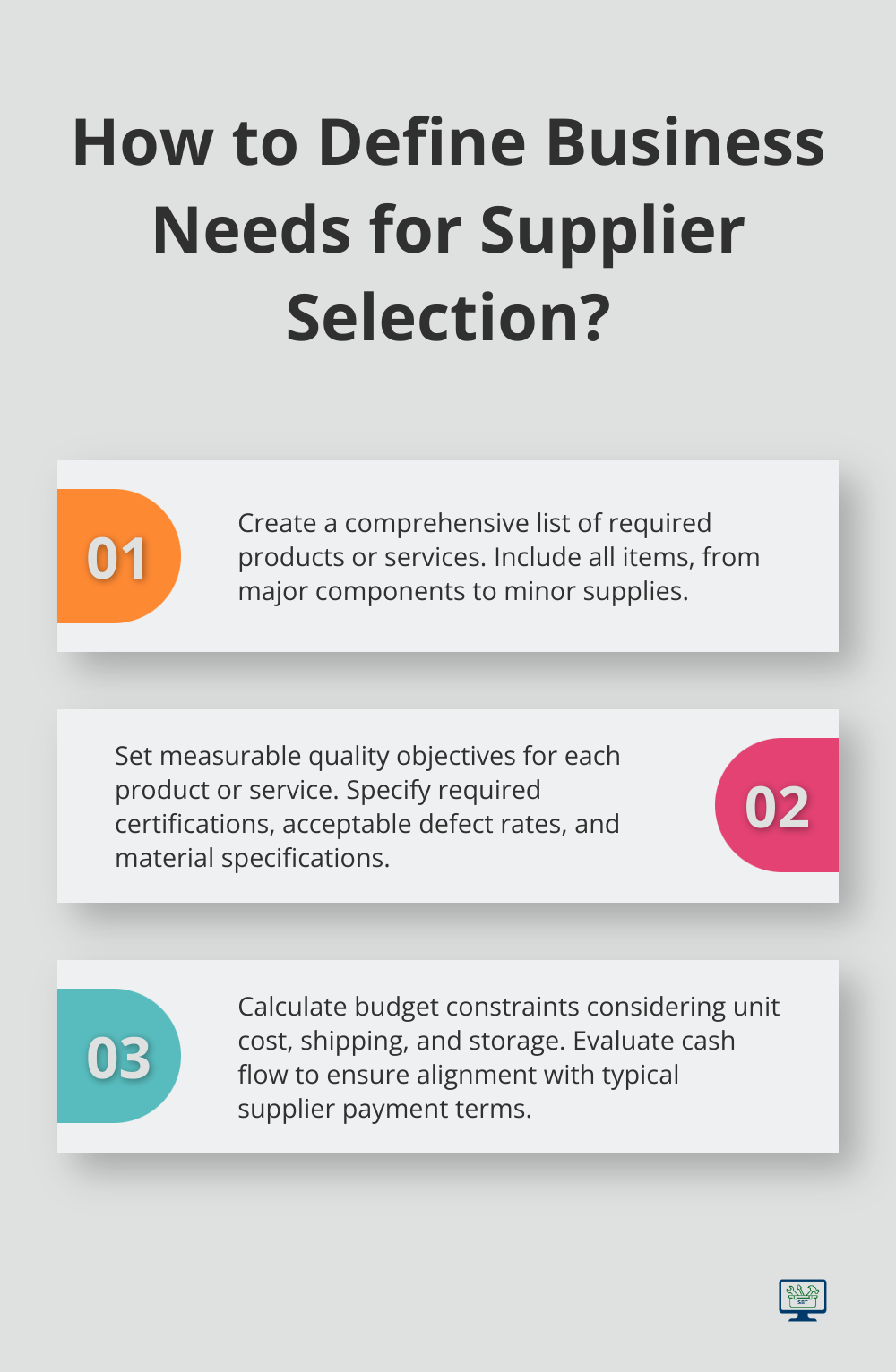
As you move forward in your supplier selection process, these clearly defined needs will serve as your compass. They’ll help you identify suppliers who can truly meet your expectations and contribute to your business success. The next step is to research and evaluate potential suppliers based on these criteria.
Where to Find Reliable Suppliers
Understanding Types of Suppliers
A comprehensive understanding of the various types of suppliers can enhance your procurement strategy. Below are key types of suppliers to consider:
| Type | Description |
| Manufacturers | Produce goods directly and may offer lower prices. |
| Wholesalers | Buy large quantities and sell smaller amounts, often at discounted rates. |
| Distributors | Act as intermediaries, providing a range of products from multiple manufacturers. |
| Importers | Bring goods from foreign suppliers to your local market. |
| Local Suppliers | Offer goods sourced from the local market, reducing shipping costs. |
You must assess each supplier type against your business needs and objectives.
Pros and Cons of Different Supplier Types
After considering the various options available for suppliers, it’s imperative to evaluate their unique benefits and drawbacks. Your choice should depend on your specific business needs and priorities. The following table breaks down the pros and cons of different supplier types:
| Supplier Type | Pros and Cons |
|---|---|
| Local Suppliers | Faster delivery times; supports the local economy. However, prices may be higher. |
| International Suppliers | Access to a broader range of products; often lower costs, but potential for longer shipping times. |
| Wholesale Suppliers | Can offer bulk discounts, which saves money, but may have minimum order quantities. |
| Manufacturers | Direct access to products, customizing options, but sometimes requires larger orders. |
| Online Suppliers | Convenience and vast selection; however, you may miss out on quality control. |
Where to find them?
Online Directories and Platforms
The internet offers a wealth of resources for finding trustworthy suppliers. Industry-specific directories like ThomasNet for manufacturers or Alibaba for global sourcing can provide valuable leads. These platforms often include supplier ratings and reviews, which offer insights into their reliability and performance.
Industry Associations
Industry associations serve as excellent resources for finding vetted suppliers. For example, the Australian Food and Grocery Council maintains a directory of suppliers in the food industry. Membership in these associations often indicates a supplier’s commitment to industry standards and best practices.
Trade Shows and Expos
Trade shows remain one of the best ways to meet potential suppliers in person. The Fine Food Australia expo allows you to see products firsthand, ask questions directly, and assess a supplier’s professionalism. Pay attention to how they present themselves and interact with potential clients – it often reflects how they’ll treat you as a customer.
Business Network Recommendations
Your existing business network can provide invaluable supplier recommendations. Contact fellow business owners in your industry or local chamber of commerce. They might share insights about suppliers they’ve worked with, including those to avoid. This peer-to-peer advice can help you avoid costly mistakes and lead you to reliable partners.
Thorough Background Checks
When you evaluate potential suppliers, conduct comprehensive background checks. Use the Australian Securities and Investments Commission (ASIC) website to verify a company’s registration and financial status. For international suppliers, services like Dun & Bradstreet offer detailed business reports.
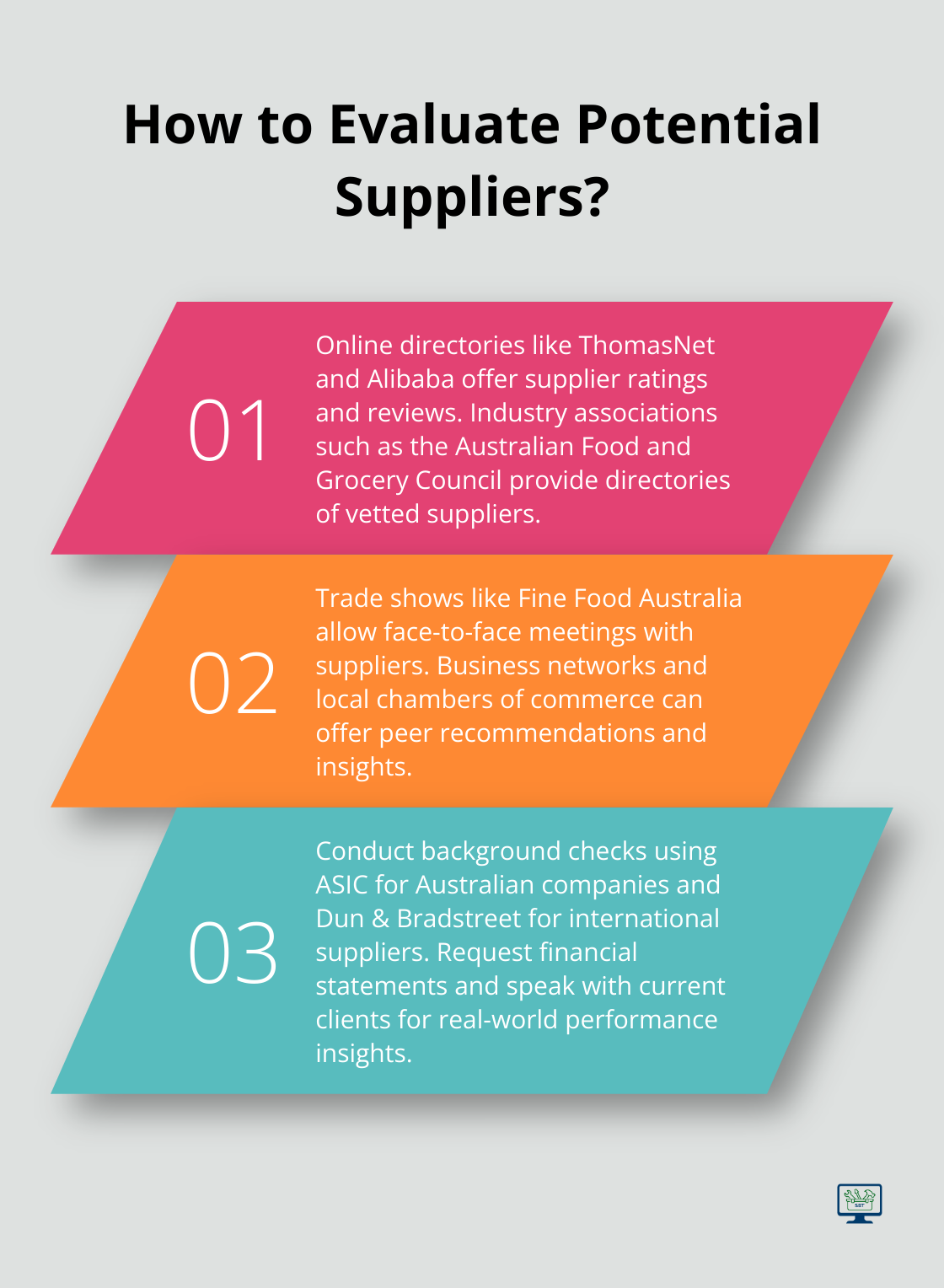
Financial stability is key. Request financial statements or credit reports from potential suppliers. A supplier with a strong financial foundation is more likely to fulfill orders consistently and withstand market fluctuations.
Don’t hesitate to ask for references from a supplier’s current clients. Speaking with these businesses can provide real-world insights into the supplier’s performance, reliability, and problem-solving abilities.
Finding the right suppliers is an ongoing process. As your business grows and evolves, so will your supplier needs. The next step in this process involves comparing and selecting the best suppliers from your pool of candidates.
How to Select the Best Suppliers
Request and Analyze Quotes
Start by requesting detailed quotes from at least three to five suppliers. This provides a solid basis for comparison and helps you understand market rates for your required products or services. When you analyze these quotes, look beyond the bottom line. Pay attention to factors such as minimum order quantities, bulk discounts, and any additional fees for shipping or rush orders.
Evaluate Quality and Reliability
Price isn’t everything. A supplier offering rock-bottom prices might cut corners on quality or reliability. Ask for product samples whenever possible. This allows you to assess the quality firsthand and determine if it meets your standards. For service providers, request case studies or examples of their work.
Ranking suppliers on various metrics helps companies figure out which of them are performing the best and where there is room for improvement. Reliability is equally important. Check their track record for on-time deliveries and order accuracy. Late or incorrect shipments can severely impact your business operations.
Assess Customer Service and Communication
Excellent customer service can make a world of difference, especially when issues arise. Test their responsiveness by asking questions about their products or services. How quickly do they reply? Are their answers helpful and comprehensive? A supplier who is attentive during the sales process is more likely to provide good support after you become a customer.
Consider Location and Logistics
The location of your suppliers can significantly impact delivery times and shipping costs. Local suppliers often offer faster turnaround times and lower shipping fees. When your supplier is just down the street or a city or two away, timing deliveries right becomes easier. However, they might have higher product costs compared to international options. Weigh these factors carefully based on your business needs.
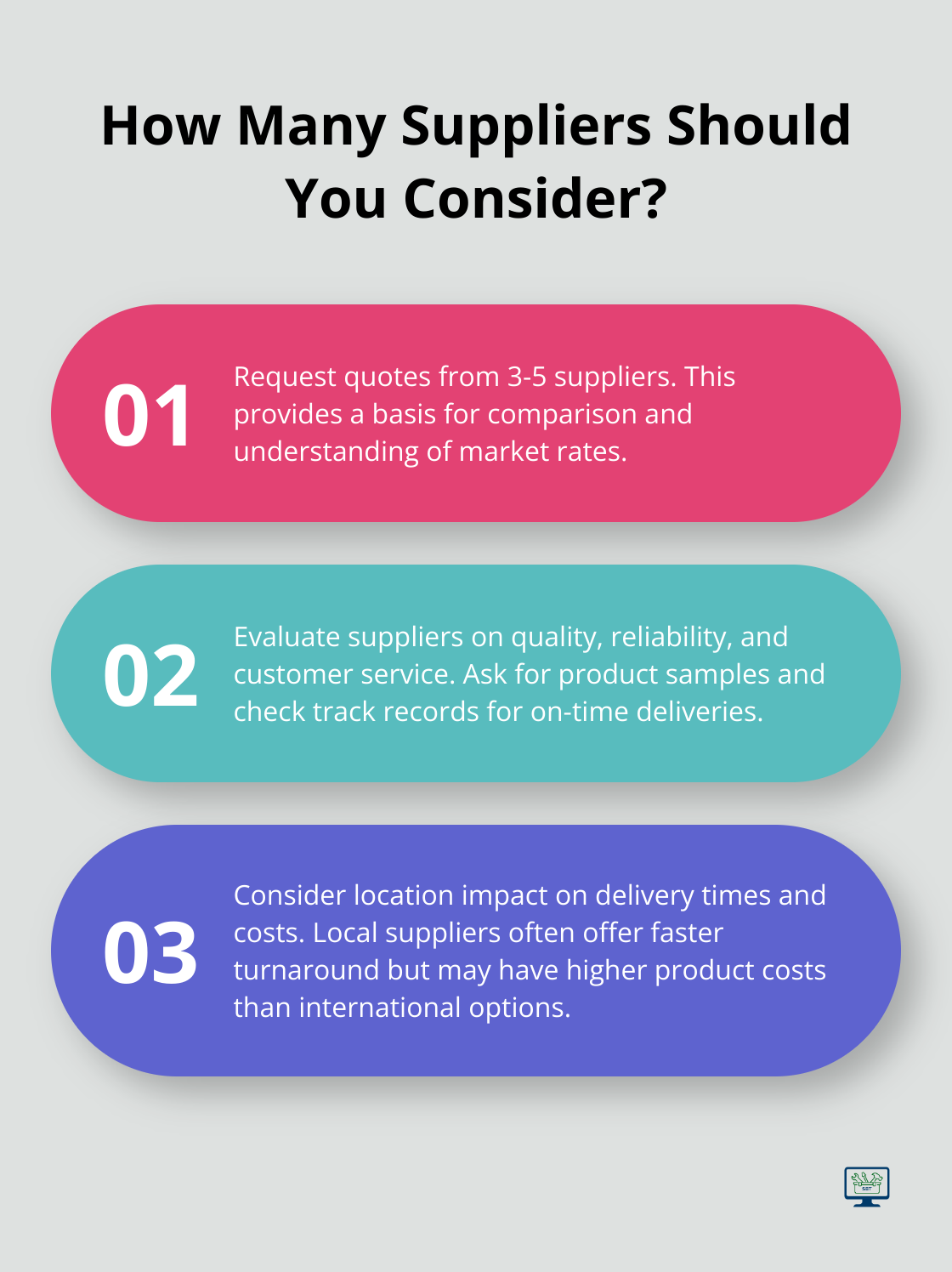
For international suppliers, consider potential challenges such as language barriers, time zone differences, and import regulations. (Australian Border Force provides guidelines on importing goods, which can help you navigate these complexities.)
Evaluate Payment Terms and Financial Stability
Favorable payment terms can greatly benefit your cash flow. Some suppliers might offer early payment discounts or extended payment periods. However, be cautious of terms that seem too good to be true – they might indicate financial instability on the supplier’s part.
Speaking of financial stability, it’s important to partner with suppliers who are on solid financial footing. A supplier going out of business could leave you in a lurch. Use resources like the Australian Securities and Investments Commission (ASIC) to check a company’s financial health.
Final Thoughts
Selecting the right small business suppliers requires careful consideration and thorough evaluation. You must define your needs, research potential vendors, and assess their offerings to establish strong partnerships. Regular performance reviews and open communication will help you maintain beneficial supplier relationships as your business grows.
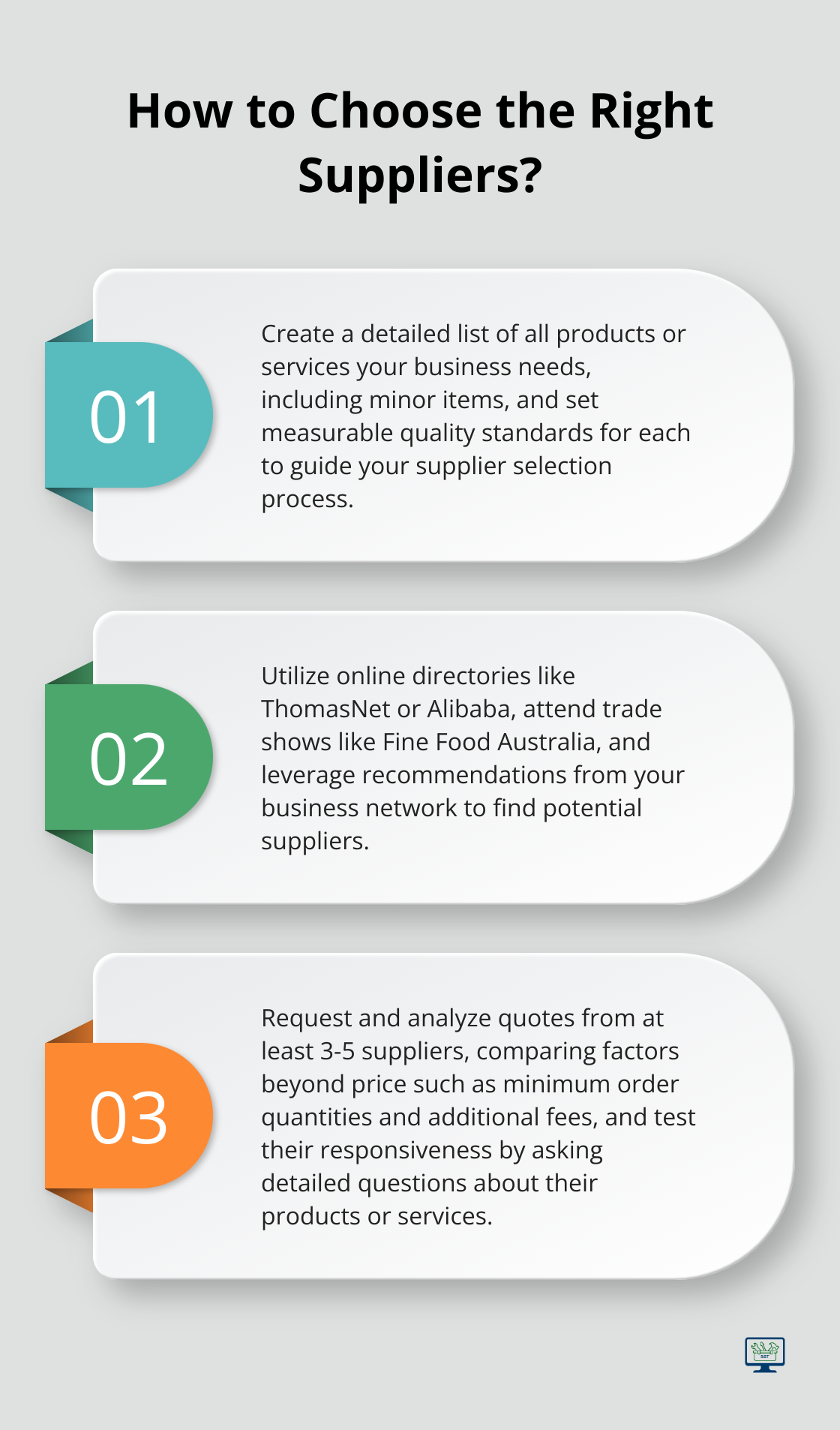
Quality products, consistent deliveries, and fair pricing from reliable suppliers contribute to customer satisfaction and healthy profit margins. These dependable partners often provide valuable insights and support beyond mere transactions, becoming integral to your business journey. At SmallBizToolbox, we offer resources and tools to help you streamline the process of finding and managing small business suppliers.
Our platform includes AI-driven content creation to improve communication with potential suppliers and SEO optimization to boost your online presence. With the right suppliers by your side, you can gain a competitive edge in today’s dynamic business landscape. Take the time to choose wisely and nurture these relationships to help your small business thrive.
FAQ
Q: What factors should I consider when selecting suppliers or vendors for my small business?
A: When choosing suppliers or vendors, it’s important to evaluate several factors. First, consider their reliability and reputation; research reviews and testimonials from other businesses. Next, assess the quality of their products or services, ensuring they meet your standards. Pricing is also vital; compare costs among different suppliers to find competitive rates. Additionally, evaluate their customer service, communication, and willingness to support your business needs. Lastly, consider their delivery times and logistics capabilities to ensure they can meet your timelines.
Q: How can I verify the legitimacy of a potential supplier or vendor?
A: Verifying the legitimacy of a supplier or vendor can involve multiple steps. Start by requesting references from their existing clients to understand their experience. You can also conduct online research; check for business registration details, license numbers, and any history of complaints or disputes. Another useful approach is visiting their business premises if applicable, allowing you to see their operations firsthand. Additionally, utilize professional networks or industry associations, which may provide insights or recommendations about reputable suppliers and vendors.
Q: What strategies can I use to establish good relationships with suppliers or vendors?
A: Building strong relationships with your suppliers or vendors is necessary for a successful partnership. Start by maintaining open and respectful communication, fostering trust and transparency. Clearly outline your expectations related to quality, pricing, and service levels from the beginning. Regularly provide feedback about their performance, both positive and constructive, to help them understand your needs better. Collaborate on problem-solving and be flexible when possible, as this shows that you value the partnership. Finally, consider building a rapport by engaging with them beyond transactional discussions, such as through networking events or informal meetings.
How useful was this Resource?
Click on a star to rate it!
Average rating 0 / 5. Vote count: 0
No votes so far! Be the first to rate this post.
We are sorry that this post was not useful for you!
Let us improve this Resource!
Tell us how we can improve this Resource?




